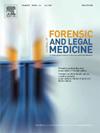长期酗酒和急性颅脑损伤医学法律尸检病例的背景特征和神经病理学发现。
IF 1.2
4区 医学
Q3 MEDICINE, LEGAL
引用次数: 0
摘要
慢性酒精使用通常与创伤性脑损伤(TBI)有关。本研究旨在比较背景特征、损伤情况、原发性脑损伤和继发性脑损伤在有和没有记录在案的慢性酒精使用史的TBI病例中。样本包括2016-2022年芬兰赫尔辛基急性头部损伤的神经病理学检查的法医尸检病例。从医疗记录和警察档案中收集了关于长期过量饮酒的数据;从医疗记录、警方档案和死因调查文件中收集了其他背景和间接数据;从尸检和神经病理学报告中收集了原发性脑损伤和继发性脑损伤的数据。该数据集包括47例病例,其中19例有慢性酒精使用史(40.4%)。殴打是慢性酒精使用者中最常见的伤害情况(47.4%),而跌倒在对照病例中最常见(32.1%);未知情况在两组中都很常见。两组间原发性头部损伤发生率和伤后生存率无统计学差异。至于继发性脑损伤,慢性酒精使用者在额叶皮质(84.2%比28.6%)、顶叶皮质(84.2%比32.1%)、海马(63.2%比25.0%)和透镜状核(73.7%比21.4%)中缺氧缺血性神经元损伤更为常见。我们的研究结果表明,慢性酒精使用者不一定有更多样化或复杂的原发性损伤,但他们可能有更广泛的继发性损伤。进一步的研究应旨在探索慢性酒精使用者缺氧缺血性神经元损伤的潜在病因。本文章由计算机程序翻译,如有差异,请以英文原文为准。
Background characteristics and neuropathological findings of medico-legal autopsy cases with chronic alcohol use and acute head injury
Chronic alcohol use is often associated with traumatic brain injury (TBI). This study aimed to compare background characteristics, injury circumstances, primary head injuries, and secondary brain injuries among TBI cases with and without a documented history of chronic alcohol use. The sample comprised neuropathologically examined medico-legal autopsy cases with acute head injuries from Helsinki, Finland, over the years 2016–2022. Data on chronic excessive alcohol use were collected from medical records and police files; other background and circumstantial data were collected from medical records, police files, and cause-of-death investigation documents; and data on primary head injuries and secondary brain injuries were collected from autopsy and neuropathology reports. The dataset comprised 47 cases, of whom 19 had a history of chronic alcohol use (40.4%). Assault was the most common circumstance of injury among chronic alcohol users (47.4%) while falls prevailed among control cases (32.1%); unknown circumstances were common among both groups. There were no statistically significant differences in the prevalence of primary head injuries or postinjury survival between the groups. As for secondary brain injuries, hypoxic-ischaemic neuronal injury was significantly more common among chronic alcohol users in the frontal cortex (84.2% vs. 28.6%), parietal cortex (84.2% vs. 32.1%), hippocampus (63.2% vs. 25.0%), and lenticular nucleus (73.7% vs. 21.4%). Our findings suggest that chronic alcohol users may not necessarily have more diverse or complex primary injuries, but they may have more extensive secondary injuries. Further research should aim to explore the potential aetiology of hypoxic-ischaemic neuronal injury among chronic alcohol users.
求助全文
通过发布文献求助,成功后即可免费获取论文全文。
去求助
来源期刊

Journal of forensic and legal medicine
MEDICINE, LEGAL-
CiteScore
2.70
自引率
6.70%
发文量
106
审稿时长
57 days
期刊介绍:
The Journal of Forensic and Legal Medicine publishes topical articles on aspects of forensic and legal medicine. Specifically the Journal supports research that explores the medical principles of care and forensic assessment of individuals, whether adult or child, in contact with the judicial system. It is a fully peer-review hybrid journal with a broad international perspective.
The Journal accepts submissions of original research, review articles, and pertinent case studies, editorials, and commentaries in relevant areas of Forensic and Legal Medicine, Context of Practice, and Education and Training.
The Journal adheres to strict publication ethical guidelines, and actively supports a culture of inclusive and representative publication.
 求助内容:
求助内容: 应助结果提醒方式:
应助结果提醒方式:


